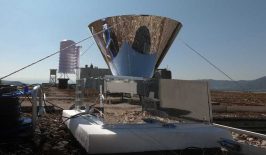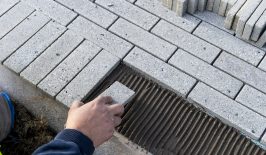Hot water is a luxury many of us take for granted. We turn on the tap, and piping hot water comes out in an instant. Of course, this is not always the case across the world, and even in the Global North, hot water is not without a cost. For example, 78 percent of water boilers in the UK are still heated by gas.
But, new technology is being developed to move away from this relationship. After all, the world is blessed with one giant natural water heater: the Sun. Solar thermal – the heating of water using the Sun’s energy – has been around for years, but it often comes with challenges. Traditional solar thermal heaters are large and unwieldy, require specialist technicians and are often of questionable economic value. Now, a Scottish startup, SolarisKit wants to tackle all of these problems with one easy-to-use solution.
SolarisKit has designed the world’s first flat-pack solar thermal heater, the SolarisKit S400. Using only basic components, anyone should be able to quickly build a water heater within only around 15 minutes. The kit consists of a plastic pyramid shaped frame and prism in which is arranged a coiled plastic pipe. Cold water from a mains connection is pumped into the lower end of the device, which then travels around the length of the coiled pipe, receiving the heat of the sun. At the other end, warm water for bathing or washing, up to 50 degrees Celsius, comes out.
A Cheaper, Cleaner Way to Heat Water
According to SolarisKit, their design offers some huge advantages over previous systems. Firstly, it is much easier to transport. Traditional solar thermal systems are often large and fragile. Their cumbersome shape also means they have special logistical requirements – making them more expensive and inconvenient to transport. In comparison, the SolarisKit has no special transport needs and can be sent through the mail like any other product. Using basic robust materials, the flat-pack version is also much less likely to suffer damage in transit.
All of this contributes to the kits’ next big advantage: cost. Full solar thermal systems can generally retail anywhere between 3,000 and 7,000 USD, which includes the equipment and labour to install them. Of course, this only makes them accessible to wealthy homeowners. In fact, most solar thermal heaters are advertised as pool heaters, giving you an idea to their usual clientele. Meanwhile, thanks to its simplistic design and transport, the SolarisKit costs 100 USD, making it much more accessible to different households in different regions.
Finally, SolarisKit also advertises itself as more environmentally friendly than other designs. Using solar thermal heating obviously already saves large amounts of energy and carbon emissions compared to fossil fuel systems. Heaters are graded by gCO2eq/kWh – or in easier terms – how many grams of carbon dioxide equivalent per kilowatt-hour of electricity are generated. Oil heaters are in the region of 310-550, while gas comes in around 210-380. A solar thermal device only generates around 10-35, with most of this coming from its manufacture and transportation.
The SolarisKit S400 could have several different applications. Although it works well enough in northern Europe, its ability to heat water is drastically improved when moved closer to the equator. As such, in a recent discussion with the BBC, CEO Faisal Ghani highlighted the flat-pack heaters potential to improve health and sanitation in the Global South. In many places, fossil fuels, sometimes used within closed confines, are used to heat water. As part of a pilot scheme, Solariskit distributed the S400 to homeowners in Rwanda to determine the kit’s performance in real world conditions, with one user reporting it provided consistently warm (15 degrees Celsius water) for his family of six.
There is, however, some limitation to the use of the SolarisKit in deprived or underserved areas. Most notably, it requires an active water connection to function, meaning comparatively speaking, it will likely only be available to middle income families in Rwanda and elsewhere. Additionally, the pilot scheme distributed 60 kits across 5 locations, meaning each pilot household was operating multiple S400s to maintain the levels of warm water they needed – increasing costs drastically.
With this in mind, SolarisKit is largely marketing its products towards home and pool owners, businesses and industry, as well as camp (and glamping) sites.
However, the company is still exploring ways of making solar thermal more accessible to more people. They are currently developing a new gravity fed version which does away with the need for a water connection or pump, making it potentially much more feasible for some users in the Global South.








